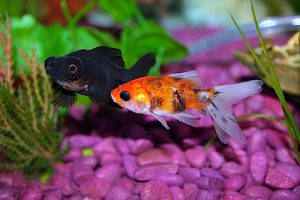
Best Aquarium Substrate Guide
The material found at the bottom of your aquarium is known as substrate. Choices for color and style are numerous, offering every aquarist the experience of personalizing their tank. Aquarium substrate sizes range from fine grains of sand to large stones. These can readily be chosen to create a natural, homely habitat for your fish that suit their individual feeding and traveling needs.
Water parameters may be met by using substrates that buffer pH and carbonate hardness in your water so that your fish feel comfortable and are less likely to catch disease. Immense biological filtration is provided by substrate because bacteria thrives on the surface area that is covered with settled debris and therefore nutrients. The best choices of aquarium substrates are as follows:
-
- Crushed Coral
-
- Gravel or River Rock
- Sand
Crushed Coral Substrate
Crushed Coral is a beautiful substrate that creates the appearance of an ocean floor. Since its colors are white and gray scale, this substrate will make your fish and coral colors stand out vividly. Containing calcium carbonate, it will help buffer the pH and hardness of your water; perfect for marine ecosystems which desire a slightly higher base pH and hardness. Crushed coral has a large surface area, making for a healthy bacteria home. However, since it has such large gaps, crushed coral catches much debris. The debris decays and the substrate turns into a nitrate factory which harms your ecosystem greatly. Being heavier and larger, invertebrates such as snails will not be able to effectively move in it to clean. Your decision to utilize crushed coral depends on your aquarium household. Plants may live with crushed coral if a bottom, soft and vitamin-rich aquarium substrate is provided. Your fish species must not have delicate fins, habits of burrowing or sleeping in sand. Ultimately, your tank household is adaptable, the decision ultimatum is whether you are willing to manual clean the substrate with a gravel-vac device to keep nitrates from building up.
| Carib Sea Crushed Coral |
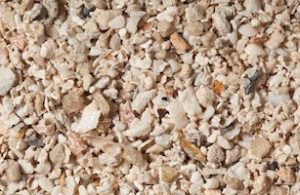 |
| View on Amazon |
Aquarium Gravel
Aquarium gravel is composed of small pieces of non-calcareous stones such as granite and basalt. Gravel is the most popular form of aquarium substrate in freshwater tanks largely because these rock choices do not affect water chemistry. This makes for a near neutral pH and softer water. Most freshwater fish prefer soft water and a neutral pH because they mimic natural habitat.Gravel is desirable for children as it is makes tank maintenance easy, colorful, and fun by:
-
- Under-gravel filters are great choices for freshwater tanks that use aquarium gravel. They work as a biological filtration system for your tank by aerating your gravel with oxygen. Bacteria growing on your gravel thrives when it has sufficient oxygen, and rapidly breeds. Your bacteria will eat debris, ammonia, and nitrites in your tank, suppressing the toxic nitrogen cycle in your tank and making your water parameters healthy. To keep under-gravel filter working efficiently, use a gravel-vac siphon to clean the gravel every one to two weeks. Getting rid of waste clogging aeration routes ensures oxygen has a path to your bacteria.
-
- Gravel comes in all colors of the rainbow. Children and most adults will be enthused to choose their favorite color for the base of their aquarium. There are colors perfect for everyone; moderate whites, grays, and blacks to make colorful fish pop, cool color blues, greens, and purples, and vibrant oranges, pinks, and reds.
-
- Gravel pieces take up large amounts of space per piece, so it is generally cost-efficient. Usually one or two small bags of gravel is sufficient to set up your tank with the recommended two or three inches height.
Before deciding upon gravel as your tank substrate, consider the delicacy of your beloved fish. Gravel can be jagged and is not for burrowing and digging. Some species of fish can be harmed or deprived of natural habits when living with gravel. For example: Cory Catfish have fragile whiskers that get damaged by being bashed against gravel.
Learn more about gravel choices here
Sand As Aquarium Substrate
Create smiles on the faces of your fish by turning their aquarium into the ultimate vacation destination. Sand is natural, beautifully textured and colored, and luxuriously soft for your fish. White sand for aquarium flooring appears fresh and allows decorations in your tank to pop out. Colored sand adds unique style to conservative decoration or a finish to a bright aquarium. Most fish prefer sand as their substrate because it is easy to move through and is delicate on their fins. It makes for a great sleeping bag and playground for your jubilant fish to play and roll in the sand like children. Consequent of sand creating a homely feel for your tank, fish are increasingly likely to spawn because they are optimally comfortable.
Though sand is a wonderful and typically harmless substance, maintain caution when establishing it in your tank:
-
- Clean the sand multiple times before adding to your aquarium to lessen the chance that it may leech unwanted bacteria and dust to your aquarium’s ecosystem.
-
- When placing sand in your tank, contain the sand until reaching the bottom of your tank.This ensures that it will not blow around, potentially getting into and harming the lungs and eyes of your fish. As a precaution, add sand to your new tank before adding livestock. If adding sand to an established tank, move your fish to an isolation tank or container while adding sand.
-
- Make sure your filter intake tubes are at least above half of your tank’s height. This prevents lowly-drifting sand from fish movement to enter your filter and be spit back out causing hazard.
- Be patient when cleaning or “gravel-vacuuming” your sand because if your vacuum too close it is easy to suck sand up. Also be aware that intensely sucking sand is dangerous; it results in flinging it back out of the vacuum and, caught by current, around your tank.
Sand is available in multitudes of colors and types. Sand types include coral sand, aragonite sand, tahitan moon sand, silica sand, “black beauty” sand, and live sand.
Learn more about various types of sand here
To add structural decor to your aquarium, as well as helping to maintain a stable pH and water hardness or softness, consider:
-
- Rock
- Wood
Aquarium Rocks
Introducing rock structures to your aquarium is visually appealing, comforting for your fish, and reacts with your water chemistry to replicate natural habitat water.
Rocks add:
-
- Vibrant landscape to your aquarium as they naturally range in color spectrum, from pure white to intense red or purple. Marine tank algae will gradually cover your rocks and change from beautiful green to dynamic purple as your tank cycles.
-
- Bacteria colonies which thrive on the surface of rocks, and suppress the nitrogen cycle in your tank by eating harmful ammonia and nitrites.
-
- Hiding places for your fish that grant them both privacy and a sense of safety which reduces their stress.
- Water chemistry alteration that buffers pH to be more basic; in chemistry terms this means the water will be above pH 7.0 which is desirable for many fish species. This will also increase carbonate hardness that also makes for comforting for your fish. These alterations are ideal for marine fish, and are usually harmless for freshwater fish.
Types of rock recommended for freshwater aquariums include slate, shale, and dried rock. For marine tanks, any of the above can be used as well as live rock. The reason live rock is not recommended for freshwater tanks is because they contain salt and marine bacteria that are harmful to freshwater habitats.
Learn more about rocks for your aquarium here.
Aquarium Wood
Wood in your aquarium makes for a great replica freshwater habitat of lakes and rivers. Common wood types used in aquariums are bogwood, mopani wood, malaysian driftwood and any other safe, petrified wood from pet stores. Wood pieces make hiding places for your fish so that they can have privacy and a comfortable spawning space. Algae and any micro-organisms will tend to live near or on the wood, and create a nutritious food source for your tank mates. Wood will decrease your tank water pH and soften the water. These parameters are favorable for freshwater fish because it nearly replicates fresh water bodies of water; their natural habitat. Points of consideration for your driftwood to ensure safety in steps are:
-
- Make sure your wood is safe for your fish. Buy your wood pieces from a pet store that guarantees the wood is safe for aquarium use. If you highly desire to take wood from nature, make sure to look up the type of wood and if it is safe for aquarium use. This dramatically lowers the risk of harm, but it still cannot be guaranteed safe.
-
- After obtaining your wood, use a clean brush to remove debris. Never use chemical cleansers or soap as they will poison and kill your tank livestock
-
- After brushing, fill a clean container or bucket with de-chlorinated or reverse osmosis water, and put your wood in. These kinds of water are mandatory because we want to keep the tank as free of excess minerals and chemicals as possible. Excess nutrients create unwanted algae blooms and water parameter problems. Soak your wood for one to two weeks depending upon how dirty the water looks. After this time period, dump out the container water and refill it with a new batch of de-chlorinated or reverse osmosis water. Let the wood soak for another week or until there is no more murkiness in the water. This will ensure that any harmful substances have leaked out of the wood.
-
- Following weeks of soaking, we just want to put the wood in the tank. However, after all this time there is no point in skipping one more small step to ensure your wood is tank-safe. The final task is to boil your wood for one to two hours. This kills any algal and fungal spores on your wood, and finishes sterilizing it fully.
- Place your wood in your tank and be joyful for you have waited weeks to see your wood in your aquarium!
To promote plant growth in your tank, add a layer of one of these great nutritious substances underneath your top layer of aquarium substrate:
-
- Carib Sea Eco-Complete
- Seachem Flourite
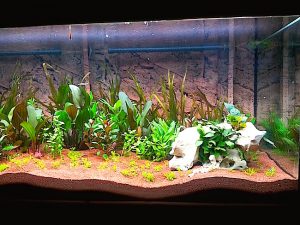
What Substrate to Use In a Planted Tank?
Aquarium plants are highly beneficial to your tank because they eat toxic nitrates which bacteria cannot eat, compete with algae for nutrients so that you do not get algae infestation, and give scenery, interaction, and oxygen for your fish. Being plants, they need essential nutrients such as iron, magnesium, potassium, and nitrogen to thrive. Without these, they will not reach their potential in color, growth, strength, and overall health. Take these measures to help your aquarium plants get, and stay healthy and blooming:
-
- Place a two-inch layer of Carib Sea Eco-Complete or Seachem Flourite under your top layer of substrate because they soak up and hold onto nutrients for your plant to eat. Cover this layer with one inch of your regular substrate to hold it down in place without suffocating it. You will still see your desired appearance of your top layer
-
- Use finer substrate, if gravel about two to five millimeters in size rather than large stones and pebbles as your tank substrate because it is easier for plant roots to develop and grow in less-heavy substrate.
-
- Keep your substrate clean because if debris cover all crevices in your substrate, your plants will be unable to breath and obtain nutrients.
-
- If your plants are growing slower than desired, or look unhealthy, make sure your lighting is two to three watts per gallon of tank water, and consider buying a specific aquarium-plant growth light.
- When your plants grow tall, if you want to create an “aqarium jungle”, feel free look up your plant type and replanting guide. For most plants, you may simply cut stems and replant pieces in your substrate. They will grow into another plant, as you can spread as many as you like. The more the merrier!
| Seachem Flourite | Carib Sea Eco-Complete |
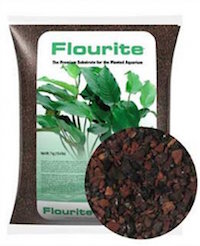 |
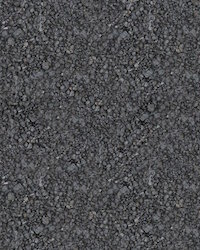 |
| View on Amazon | View on Amazon |
Aquarium Substrate Depth
Building your substrate layer to be four inches or lower in height enforces safety, comfort, and aesthetic appeal. While it may seem inviting to envision an aquascape featuring rolling hills of sand, it is not recommended to allow your sand height to be above four inches because:
-
- Moving water from filters, pumps, and fish movement will constantly knock down high beds of substrate and even them out. When falling, substrates such as sand may be hazardous. They may blow around your tank and enter into the lungs or un-closable eyes of your fish.
- Toxic nitrogenous bubbles may accumulate in undisturbed substrate; water movement cannot penetrate deep substrate. Watch for these bubbles as they release gases deadly to fish.
See note below about preventing toxic bubbles:
Note: Do not keep deeply rooted plants in a tank with high sand levels. Growing roots may pop nitrogenous bubbles and release toxic gases into your tank. Great prevention can be sought by the addition of Malaysian Trumpet snails to your tank. They sift through and clean very deep sand beds, along with constantly disturbing substrate to prevent nitrogenous bubbles. Another option to keep your substrate disturbed is to manually stir the tank each week with your hand or any device.
Bare Bottom Aquarium
Bare bottom aquariums are used for fish breeding, fry raising, quarantine tanks, and temporary-housing display tanks in pet stores. Bare bottom tanks are sometimes used to make catching fish easier in temporary tanks. Maintaining a bare floor is easy as debris does not get trapped. For small tanks with inadequate filtration and no intertebrates to clean debris off your aquarium substrate this may be beneficial. A buildup of decomposing debris may cause algae bloom and increased ammonia, nitrite and nitrate levels, resulting in fish illness.
This also means that no healthy bacteria will grow on the bottom of your tank. Substrate serves as a huge, natural surface area for bacteria colonies which eat ammonia and nitrates. Light can bounce off the bottom of your tank and stress our your fish, potentially causing aggressiveness and vulnerability to disease. Deciding whether a bare bottom tank is right for you depends on the inhabitants of your aquarium. No substrate bottoms are not recommended for tanks with plants and certain fish because:
-
- Plants cannot stay in place without substrates to hold them in place. Minerals enable plants in your aquarium to become colorful, grow larger, and have strong leaves and stems.
- Tiny critters such as copepods and amphipods provide beneficial nutritional sources of food for your fish and corals. The majority of these pods will make homes and breed in your substrate. To not have substrate means to not make copepods and amphipods comfortable in your tank; you may have some, but much less because you are not allowing them a home.
- Coral-based substrates buffer water pH and hardness, improving fish comfort. These buffers dramatically assist saltwater tanks in reaching the recommended pH between 8.0 to 8.4. For freshwater tanks that require a pH of only 6.0-7.0, substrate is not crucial for pH reasons.
- Various species of fish have different personalities and habits. Timid fish may camouflage with substrate to feel safe and stay de-stressed. Dragonets burrow into sand blankets before sleep to feel safe, warm, and comfortable. Jawfish species spend hours burrowing tunnels in sand for enjoyment and safety. Sand-sifting gobies intake sand for food, filtering the nutrients out of the sand through their gills.
Cleaning Aquarium Substrate
Keeping your tank clean is a fundamental of the aquarium hobby. Without a clean tank, water parameters spike out of control, fish catch diseases, plants droop, and tank appearance turns dirty. Aquarium substrate largely impacts the cleanliness of your aquarium because the debris that settles on it is the same debris that decomposes into excess nutrients and harms your tank water parameters. Luckily, cleaning your aquarium substrate is easy with the use of our filters, gravel-vacs, and turkey basters. Simple advice for substrate cleaning is as follows:
-
- Add snails, crabs, and shrimps to your tank if they are compatible with your fish because they eat debris and waste from your substrate before it decomposes.
-
- A couple times a week use a turkey baster and blow debris off of your substrate. It will blow through the water, and a large majority will get sucked into your filter.
-
- Once every one to two weeks when needed, use a gravel-vac to suck up debris and waste on the top inch of your substrate. Remember never to suck deeper than this because it will uproot plants and blow substrates around your tank causing hazard. To use your gravel-vac, put the gravel-vac sucking end into your tank. Squeeze turkey baster to maintain pressure and stick it into the end of the tubing. Then, release the pressure on the turkey baster to cause a siphon effect and start cleaning your substrate. To stop the siphon simply remove the gravel-vac from your tank.
-
- Change ten to fifteen percent of your water every couple weeks to keep algae levels down. This ensures that waste will buildup less because there will be less algae growing and dying in your tank.
-
- Stir your substrate slightly every week or two to keep your bacteria oxygenated. This ensures your beneficial bacteria will keep breeding and eating debris and waste from your tank.